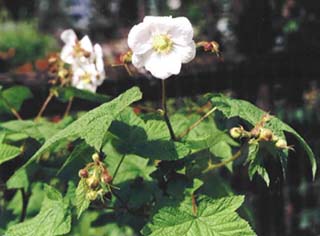
Rubus parviflorus ©Lory Duralia
HOME • return to plant lists: habitats • all plants • riparian • woodland • sun • subalpine • butterflies • birds
Thimbleberry · Rubus parviflorus

Description: deciduous shrub (3-6 ft.) with soft, palmately-lobed leaves, big white flowers (late spring/summer), and edible red fruit. Thimbleberry is a beautiful shrub for wildlife; its fruit attracts grosbeaks, jays, robins, sparrows, towhees, waxwings, woodpeckers and wrens, and flower nectar is enjoyed by hummingbirds. It can be aggressive. Part sun, moderate-regular water.
Lewis and Clark collected thimbleberry in either Washington or Oregon. On the label Frederick Pursh wrote "A Shrub of which the natives eat the young Sprout without kooking. On the Columbia Aprl. 15th 1806." On April 8, 1806, Lewis wrote a description of thimbleberry, distinguishing it from salmonberry, with which he had gotten it confused: "the shrub [thimbleberry] which I have herefofore confounded with this [salmonberry] grows in similar situations, has a stem precisely like it except the thorn and bears a large three loabed leaf."